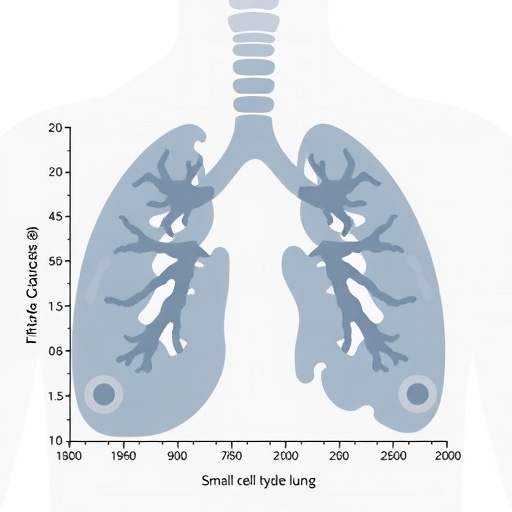In the realm of oncology, the treatment of extensive-stage small cell lung cancer (ES-SCLC) remains one of the most challenging areas, demanding a nuanced understanding of real-world treatment patterns and clinical outcomes. A recent study spearheaded by Sankar et al. delves into this intricate landscape, shedding light on the therapeutic journeys of patients who have undergone first-line platinum-based chemotherapy followed by at least two additional lines of therapy within the United States. This comprehensive analysis not only provides a snapshot of current practices but also opens avenues for further exploration in patient management and treatment optimization.
The study is particularly relevant given the aggressive nature of SCLC, which is known for its rapid progression and poor prognosis. On diagnosis, many patients find themselves at an advanced stage, making timely and effective treatment crucial. Traditional approaches often start with platinum-based chemotherapy, considered the standard initial treatment. By examining the subsequent lines of therapy administered after first-line treatment, Sankar et al. have been able to map out the intricacies of patient care in real-world settings.
One of the standout findings from the research indicates that follow-up treatment strategies vary widely among patients. This variability can be attributed to a myriad of factors, including the individual patient’s overall health, the specific characteristics of the tumor, and the availability of subsequent therapies. Understanding these factors can significantly enhance the precision of treatment plans and potentially lead to improved clinical outcomes.
In addition to treatment patterns, the study meticulously evaluates clinical outcomes associated with different therapeutic strategies post-first-line chemotherapy. By examining patient records across diverse demographics and treatment modalities, the research highlights the stark reality that while some patients may derive significant benefit from multiple lines of therapy, others experience minimal improvements. This disparity points to a critical gap in personalized medicine approaches, emphasizing that treatment must be tailored not just to the disease but to the patient’s unique profile.
The use of real-world data in this study is a key strength, allowing for insights that controlled clinical trials may not capture. Real-world evidence provides a broader context for understanding how treatments perform outside of the stringent conditions of a trial. As oncologists increasingly seek to integrate real-world evidence into their decision-making processes, studies like this serve as vital resources for informing best practices.
Moreover, examining the adverse effects experienced by patients throughout their treatment journeys is a crucial aspect covered by Sankar et al. Understanding the side effects associated with different lines of therapy is indispensable for improving patient quality of life and ensuring adherence to treatment regimens. High toxicity levels can lead to treatment discontinuation or delays, creating a cycle that hampers overall effectiveness and hinders optimal patient care.
In synthesizing the findings, the authors aptly illustrate the importance of multi-disciplinary approaches in managing ES-SCLC. By fostering collaboration among oncologists, palliative care specialists, and supportive care teams, there is potential to enhance not only the survival rates but also the quality of life for these patients. The confluence of expertise from different fields can pave the way for more holistic treatment strategies that address both the physical and emotional challenges faced by patients.
The study also raises pertinent questions regarding the economic implications of various treatment pathways. As healthcare costs continue to rise, understanding the cost-effectiveness of different therapy lines becomes increasingly critical. Finding a balance between treatment efficacy and economic feasibility can help stakeholders make informed decisions that ultimately benefit patients without placing an unsustainable burden on healthcare systems.
As the landscape of cancer treatment continues to evolve, the role of innovative therapies cannot be overlooked. Advancements in targeted therapies and immunotherapy hold promise for improving outcomes even in advanced stages of disease. The juxtaposition of traditional chemotherapy with emerging modalities presents exciting potential, but also necessitates rigorous investigation into their applicability within real-world contexts.
Through this study, Sankar et al. invite the wider oncological community to reflect on existing treatment paradigms and consider how they might be recalibrated in light of emerging data. Continued research into real-world treatment patterns is essential for refining protocols and possibly reshaping the trajectory of care for patients battling extensive-stage small cell lung cancer.
Moreover, the need for ongoing education and training for healthcare practitioners is underscored. As new therapies and techniques are introduced into practice, healthcare providers must remain abreast of advancements to ensure they are delivering the most current and effective standards of care to their patients.
Ultimately, research such as this underscores the need for a patient-centered approach to cancer treatment that prioritizes individual needs and outcomes. By placing patients at the heart of treatment discussions, we can better navigate the complexities of cancer care, enhancing not only survival rates but also overall life satisfaction in this arduous journey.
In conclusion, the findings from Sankar et al. offer a foundational resource for understanding real-world treatment patterns and clinical outcomes among patients with extensive-stage small cell lung cancer. This research marks a significant step towards optimizing treatment protocols and improving the overall patient experience in what remains one of the most formidable challenges within oncology.
Subject of Research:
Real-World Treatment Patterns and Clinical Outcomes in Patients With Extensive-Stage Small Cell Lung Cancer
Article Title:
Sankar, K., Unni, S., Eberl, M. et al. Real-World Treatment Patterns and Clinical Outcomes in Patients With Extensive-Stage Small Cell Lung Cancer Treated With First-Line Platinum-Based Chemotherapy and ≥ 2 Subsequent Lines of Therapy in the United States. Adv Ther (2025).
Article References:
Sankar, K., Unni, S., Eberl, M. et al. Real-World Treatment Patterns and Clinical Outcomes in Patients With Extensive-Stage Small Cell Lung Cancer Treated With First-Line Platinum-Based Chemotherapy and ≥ 2 Subsequent Lines of Therapy in the United States. Adv Ther (2025). https://doi.org/10.1007/s12325-025-03408-z
Image Credits:
AI Generated
DOI:
https://doi.org/10.1007/s12325-025-03408-z
Keywords:
Small Cell Lung Cancer, Chemotherapy, Treatment Patterns, Clinical Outcomes, Patient-Centered Care, Oncology, Real-World Evidence.




